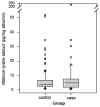Genetic variations of hepatitis B virus and serum aflatoxin-lysine adduct on high risk of hepatocellular carcinoma in Southern Guangxi, China
- PMID: 20650537
- PMCID: PMC6022746
- DOI: 10.1016/j.jhep.2010.04.032
Genetic variations of hepatitis B virus and serum aflatoxin-lysine adduct on high risk of hepatocellular carcinoma in Southern Guangxi, China
Abstract
Background & aims: Southern Guangxi area is one of the endemic areas for hepatocellular carcinoma (HCC) in China. This study evaluates the roles of genetic variations of hepatitis B virus (HBV) and aflatoxin B(1) (AFB(1)) exposure in the formation of HCC in this high-risk area.
Methods: The study recruited 60 HCC patients and 120 age-, gender-, and residency-matched controls. HBV genotype and basic core promoter (BCP) mutations were determined by nested-PCR/direct sequencing. Serum AFB(1)-lysine adduct was measured by high performance liquid chromatography-fluorescence detection.
Results: HBV genotype C was predominant in 75.0% of cases and 84.2% of controls. The 1762(T)/1764(A) double mutations, 1753(V) mutations, and 1752(V) mutations were associated with HCC risk evidenced by the adjusted odds ratio (OR) [95% confidence interval (95% CI)] of 3.89 (1.40-10.77), 2.87 (1.49-5.49), and 5.96 (1.75-20.25), respectively. The adjusted OR (95% CI) was 6.94 (1.68-27.78) for subjects with 1762(T)/1764(A) double mutations and high AFB(1)-lysine adduct level; 2.01 (0.24-14.29), for those with only 1762(T)/1764(A) double mutations; and 4.26 (1.16-15.38) for those with only high AFB(1)-lysine adduct level, respectively. The adjusted OR was 5.13 (1.79-14.71) for subjects with 1753(V) mutations and high AFB(1)-lysine adduct level; 1.20 (0.47-3.08) for those with only 1753(V) mutations, and 2.28 (1.01-5.31) for those with high AFB(1)-lysine adduct level, respectively.
Conclusions: These data confirmed the association of BCP mutations with HCC risk and the additive effects of 1762(T)/1764(A) double mutations and 1753(V) mutations with dietary AFB(1) exposure in this high-risk area for HCC.
Copyright © 2010 European Association for the Study of the Liver. Published by Elsevier B.V. All rights reserved.
Figures

Similar articles
-
[The association between aflatoxin exposure and primary hepatocellular carcinoma risks: a case-control study in Chongqing].Zhonghua Yu Fang Yi Xue Za Zhi. 2017 Jun 6;51(6):539-545. doi: 10.3760/cma.j.issn.0253-9624.2017.06.016. Zhonghua Yu Fang Yi Xue Za Zhi. 2017. PMID: 28592100 Chinese.
-
Aflatoxin B1 exposure increases the risk of hepatocellular carcinoma associated with hepatitis C virus infection or alcohol consumption.Eur J Cancer. 2018 May;94:37-46. doi: 10.1016/j.ejca.2018.02.010. Epub 2018 Mar 20. Eur J Cancer. 2018. PMID: 29533866 Free PMC article.
-
Etiological and molecular profile of hepatocellular cancer from India.Int J Cancer. 2013 Jul 15;133(2):437-45. doi: 10.1002/ijc.27993. Epub 2013 Feb 13. Int J Cancer. 2013. PMID: 23233429
-
A review of molecular mechanisms in the development of hepatocellular carcinoma by aflatoxin and hepatitis B and C viruses.J Environ Pathol Toxicol Oncol. 2013;32(2):165-75. doi: 10.1615/jenvironpatholtoxicoloncol.2013007166. J Environ Pathol Toxicol Oncol. 2013. PMID: 24099430 Review.
-
Factors predicting occurrence and prognosis of hepatitis-B-virus-related hepatocellular carcinoma.World J Gastroenterol. 2011 Oct 14;17(38):4258-70. doi: 10.3748/wjg.v17.i38.4258. World J Gastroenterol. 2011. PMID: 22090781 Free PMC article. Review.
Cited by
-
Mycotoxin exposure is associated with increased risk of esophageal squamous cell carcinoma in Huaian area, China.BMC Cancer. 2019 Dec 16;19(1):1218. doi: 10.1186/s12885-019-6439-x. BMC Cancer. 2019. PMID: 31842816 Free PMC article.
-
Association between aflatoxin B1 occupational airway exposure and risk of hepatocellular carcinoma: a case-control study.Tumour Biol. 2014 Oct;35(10):9577-84. doi: 10.1007/s13277-014-2231-3. Epub 2014 Jun 25. Tumour Biol. 2014. PMID: 24961349 Free PMC article.
-
Hepatitis B virus infection and the risk of hepatocellular carcinoma.World J Gastroenterol. 2011 Nov 28;17(44):4853-7. doi: 10.3748/wjg.v17.i44.4853. World J Gastroenterol. 2011. PMID: 22171125 Free PMC article. Review.
-
Next generation sequencing identifies baseline viral mutants associated with treatment response to pegylated interferon in HBeAg-positive chronic hepatitis B.Virus Genes. 2019 Oct;55(5):610-618. doi: 10.1007/s11262-019-01689-5. Epub 2019 Jul 29. Virus Genes. 2019. PMID: 31359359
-
Protein phosphatase magnesium-dependent 1δ (PPM1D) mRNA expression is a prognosis marker for hepatocellular carcinoma.PLoS One. 2013;8(3):e60775. doi: 10.1371/journal.pone.0060775. Epub 2013 Mar 28. PLoS One. 2013. PMID: 23556002 Free PMC article.
References
-
- Garcia M, Jemal A, Ward EM, Center MM, Hao Y, et al. Global Cancer Facts & Figures 2007. Atlanta, GA: American Cancer Society; 2007.
-
- Kao JH. Hepatitis B viral genotypes: clinical relevance and molecular characteristics. J Gastroenterol Hepatol. 2002;17:643–650. - PubMed
-
- Miyakawa Y, Mizokami M. Classifying hepatitis B virus genotypes. Intervirology. 2003;46:329–338. - PubMed
Publication types
MeSH terms
Substances
Grants and funding
LinkOut - more resources
Full Text Sources
Medical

